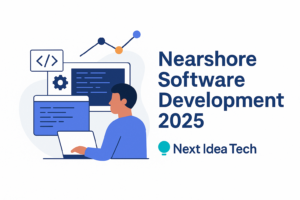Next Idea Tech was founded to solve a simple but pervasive challenge: The software developer shortage facing the US job market and the structural challenges that prevent tech talent and businesses from connecting. We saw an opportunity to build a business around providing high quality engineering-as-a-service via nearshore software development teams. Our initial strategy was to source and assess mid-level and senior engineers talent in Latin America, train them with a heavy emphasis on remote work and soft skills and then place them as full-time distributed engineers.
Hire the best developers in Latin America. Get a free quote today!
Contact Us Today!You see, before you dive in and start investing your money to build your application or software platform, if you don’t have the right people on your team then you’re setting yourself up for failure. A lot of people dive in and hire whoever gives them the best price. But they get to the end just before their launch and realize that from the beginning that software development team didn’t even have what it takes and the result is they’re looking at something that they literally have to throw away rather than taking it to the customer.
And therein lies the problem. There are a lot of people; business owners, entrepreneurs, innovators, et al, and they’re getting their software products built but they don’t have a clue what types of skillsets are needed, what types of processes they need to follow—-even though people are saying yes to them each and every step of the way; saying yes we can do this and yes it’s coming. You need to know as a business leader how to cut through that and really get to the core of what is it going to take to have your software build be successful.
In this comprehensive guide, you’ll learn what it takes to build effective nearshore software development teams and set yourself up for success.
What is a Nearshore Software Development Team?
A nearshore software development team is a group of professionals located in a neighboring or nearby country, typically in the same time zone as the client company, working together to develop a piece of software from initial ideation to completion.
They take care of your product through its entire software development life cycle (SDLC). This includes:
- Gathering and analyzing requirements
- Planning the development process
- UI/UX design
- Development
- Testing and QA
- Deployment
- Maintenance
Their exact duties and responsibilities depend on various factors, such as:
- The size and type of the project they’re working on
- The dev team’s structure
- Your company’s specific needs
With this in mind, when building a nearshore software development team, it’s imperative that you structure your recruitment process in a way that enables you to build a multidisciplinary team of highly skilled individuals who can deliver consistent results.
What Roles are Needed to Make Up a Good Nearshore Software Development Team?
There are many ways to organize a nearshore software development team. The structure of the team depends a great deal on the size of the project and methodology the company is using. While some are organized in strict hierarchies in which everyone’s roles and responsibilities are clearly defined, many others consist of small, self-organizing, cross-functional teams in which all members contribute to the development and completion of the entire project.
And this is not as standard as one would think.
For instance, for a small-mid size project you could have:
- Project Manager
- Tech Lead
- UX/UI Designer
- Software Engineers (senior, mid-level, junior in large teams)
- Quality Engineers (aka testers)
- Manual Tester
- Automation Tester or SDET (Software Development Engineer in Tests)
Let’s take a detailed look at the most essential business and technology-centered roles and responsibilities for any typical software development team.
Project Manager
A project manager is a professional who organizes, plans, and executes projects while working within restraints like budgets and schedules. In the nearshore project development teams, project managers lead entire teams, define project goals, communicate with stakeholders, and see a project through to its closure.
They’re typically responsible for ensuring their team spends the proper amount of time on each stage of the development process and that the pipeline is flowing smoothly. Ultimately, the project manager is accountable for the success or failure of the project.
Throughout the software development lifecycle, the project manager is responsible for:
- Defining the scope of the project
- Staying on schedule
- Planning a project’s cost and sticking to a budget
- Managing project resources (including teams and workers)
- Documenting the progress of the project
- Communicating with stakeholders
- Managing expectations for each project by keeping the client informed about what to expect
- Assessing risks
- Troubleshooting
- Leading quality assurance
In Software Houses you will find “Project Managers” that should be “transparent” and “minimal”. Otherwise he/she will try to be the boss and hence handicap the team.
You could also find a Business Analyst who is helping the Product Manager to maintain the backlog (list of stuff to build) and analyze it (the requirements, check if they are integral, etc). But sometimes he/she is just a scribe who acts as a proxy between the PM and the team (this is an anti-pattern).
In non-mature teams you could also find a “Scrum Master” who does… something. But in my opinion he/she should not be there, because the Tech Lead should be senior enough to carry out the development.
Technical Lead
A technical lead or tech lead for short is a highly-skilled software developer who has to think through all the technical aspects of the project and is responsible for making high-level architectural and design choices, selecting technical standards (for instance, determining the technology stack to use), guiding team members in technical matters, and general project management including managing individual priorities, deadlines, and deliverables. Most tech leads are also individual contributors.
Some key job responsibilities of a tech lead include:
- Leading the implementation and delivery of projects
- Providing technical leadership, judgment, and guidance to individuals
- Establishing project specifications and technical direction
- Defining metrics for success
- Delegating tasks to team members and achieving daily, weekly, and monthly goals
- Creating a framework of technical standards and procedures
- Keeping track of issues that arise during testing or deployment
- Overseeing software quality and system modifications
- Analyzing existing operations to identify risks and redundancies
- Documenting all the processes used by the team so they can be properly communicated to new members of the team and so that these processes can improve over time
Overall, the technical lead needs to have a great deal of professional experience in software development and a deep understanding of technology. They should also be personable and capable enough to effectively lead a team and collaborate with others.
User Experience (UX) Designer
User experience (UX) designers focus on the interaction that users have with products, like websites, apps, and physical objects. They make those everyday interactions useful, enjoyable, and accessible by applying foundational UX concepts, like user-centered design, accessibility, and equity-focused design
UX designers are responsible for the entire design process from beginning to end, including: empathizing with users; defining user pain points; coming up with ideas for design solutions; creating wireframes, mockups, and prototypes; testing designs through usability studies; iterating on designs based on feedback.
User Interface (UI) Designer
A UI designer is someone who designs the graphical user interface of an app or website. They are tasked with designing what digital products look like and how users interact with them. For example, when you access a website or an app on your phone, there’s usually a graphical interface that allows you to navigate and achieve your goal. UI designers create and optimize the interactive elements that facilitate your actions, such as buttons, menus, breadcrumbs, progress bars, and accordions. The UI designer plays a crucial role in ensuring that navigating through the site or app is intuitive, meaning that you have a good idea of what will happen if you click a button or flip a toggle switch.
Some of the tasks and decisions that a UI designer is responsible for include:
- Collaborating with UX designers, development teams, and product teams
- Creating wireframes or high-fidelity (hi-fi) layouts to show what an interface looks like with visual elements and branding included
- Translating business requirements to functional UI design
- Making style guides for design consistency across screens
- Choosing color palettes, fonts, and typesetting
- Ensuring designs can adapt to multiple device types (responsive design)
- Testing new designs on mobile and desktop
Software Engineer
Software engineers apply engineering principles and knowledge of programming languages to design and build software solutions that help solve problems that real people face. This requires a combination of technical know-how and solid communication skills. In addition to building their own systems, software engineers also test, improve, and maintain software built by other engineers.
Software engineers usually fall into one of two categories; systems engineers and application developers. Systems engineers build things like computer systems and networks that applications need to function while application developers work on either the front or back end of the system, designing software that the end user will interact with, for example; mobile and desktop applications.
Some skills to look out for when hiring software engineers include; experience with coding languages like Java, Python, PHP, C#, Swift, or Go; Object-oriented programming; Database architecture; Cloud computing; Version control; Design testing and debugging.
QA Engineer
A quality assurance (QA) engineer is tasked with ensuring that the software product runs properly. They try to prevent faulty apps or other technology from getting to the customer by running a variety of manual and automated tests while the product is in development. The goal is to try and break the product or force it to malfunction. This empowers developers with the knowledge they need to make product adjustments before it goes to market.
To test software, QA engineers will create verification protocols and script test cases that present step-by-step what needs to be done to check that a feature works. Some of the tests that a QA engineer runs include Unit tests, Integration tests, System tests, Performance tests, Regression tests, and User acceptance tests.
Navigating the Recruitment Process for Nearshore Development Teams
Let’s discuss some practical strategies to help you navigate the nearshore software developer recruitment process.
- Define your requirements and expectations: Before you begin the recruitment process, clearly define your requirements and expectations. This includes your budget, project timeline, required skills, and experience level. Understanding your needs will help you identify the right partner and save time and resources.
- Choose a reputable vendor: Partnering with a reputable vendor with experience in nearshore IT outsourcing is essential. Look for companies with a proven track record of successful projects, good communication skills, and an experienced team of software developers.
- Communicate effectively: Communication is vital when it comes to nearshore software development. Ensure you have a clear communication plan, including regular check-ins, project updates, and progress reports. Use collaboration tools like video conferencing, project management software, and instant messaging to stay connected with your team.
- Conduct thorough interviews: When interviewing potential candidates, ask specific questions related to your project requirements. This will help you determine whether they have the skills and experience to complete the job successfully.
- Pick the right partner: Building a solid relationship with your nearshore software development partner is crucial to the success of your project. Treat your partner as an extension of your team and invest time in building a positive working relationship. This will help ensure open communication, trust, and a successful outcome.
How Next Idea Tech Can Help Set Up a Nearshore Software Development Team
Are you struggling to find the right talent to cover skill gaps in your software development team?
Next Idea is a one-stop solution for expanding your team with ready-to-hire talent. We are a remote-first, nearshore software outsourcing company looking to unlock untapped potential in Latin America by providing the most knowledgeable, experienced and highly trained nearshore software engineers, and thus allowing our clients to fill tech roles at very short notice (typically 3 – 5 days). Next Idea Tech is led by a team of veteran software engineers and IT professionals — we understand the developers mindset. By partnering with us you gain access to pre-vetted talent that’s ready to make a difference.
To streamline the recruitment process, we have built an exhaustive recruitment process, consisting of five stages to assess the candidate’s skill set, values, ethics, experience, etc.
We look for team members who:
- Possess a combination of soft and hard skills
- Share our company’s values and capabilities
- Can adapt to specific project requirements
Furthermore, we limit our pool of collaborators exclusively to senior developers with at least 5 years of experience. This way, you can be sure that you’re getting professionals with a solid technical background and ideally, with previous experience working on US-based projects.
English language proficiency is a prerequisite for all our developers, more so because we primarily provide staff augmentation services to US companies. Therefore all engineers should be in a position to communicate effectively with their managers and peers.
From sourcing relevant talent using our AI enriched database, technical interviews to managing payroll and NDA compliance, Next Idea is a one-stop solution for expanding your team with ready-to-hire talent. We are led by a team of veteran software engineers and IT professionals – we understand the developers mindset. By partnering with us you will gain access to pre-vetted talent that’s ready to make a difference.
Learn more about how to hire nearshore software developers in 2024.




